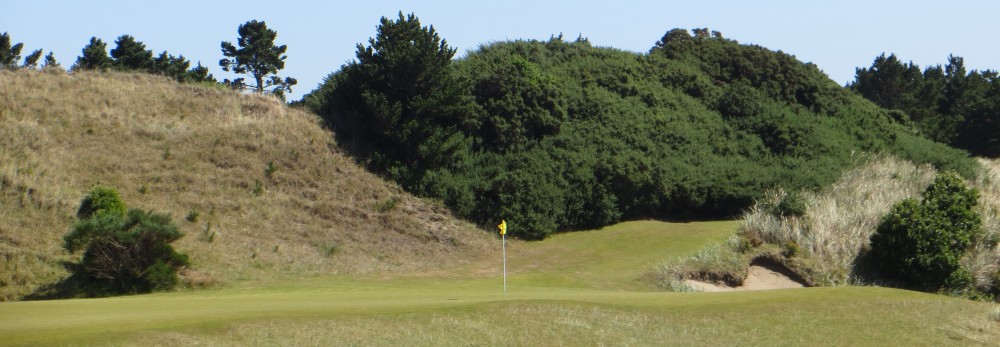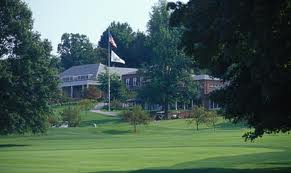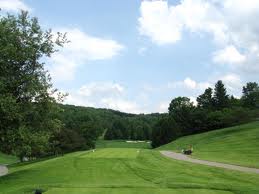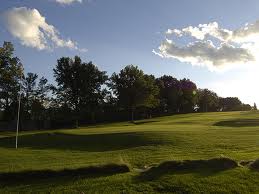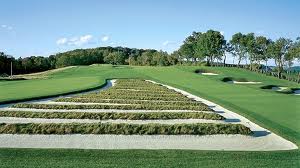 In 1914 the members of the Merion Golf and Cricket Club tapped one of their premier players, Hugh Wilson, with the responsibility of creating a championship golf course on a mere 110 acres of hilly ground outside of Philadelphia. This was no small task considering he had no previous experience in course design. He took a trip to England to study the construction of the great courses of the British Isles and came back inspired that his first stab at golf design could be a success.
In 1914 the members of the Merion Golf and Cricket Club tapped one of their premier players, Hugh Wilson, with the responsibility of creating a championship golf course on a mere 110 acres of hilly ground outside of Philadelphia. This was no small task considering he had no previous experience in course design. He took a trip to England to study the construction of the great courses of the British Isles and came back inspired that his first stab at golf design could be a success.
With the invaluable help of a young William Flynn as his lead construction man, later one of the most prolific designers of this Golden Age of course design, the two of them created one of the memorable tracks one will ever play. Except for Pine Valley, Oakmont, and Pebble Beach, there are no other examples of such quality design by an individual on his first try.
Merion has a certain mysterious quality about it that kind of creeps into your mind long after you have left the course. The sequence of holes defies any obvious pattern which gives you a sense of arbitrary fate as you work your way through the course. There are no distance markers on the course either on the tees or in the fairways-no indications of pin positions. Fortunately, there are a group of the most knowledgeable caddies you will find anywhere, and they know the distance from every blade of grass on the course and the break on every putt down to the most subtle nuance.
This is a course that asks you to show great patience, to wait for the opportunities as they occur. You cannot force a good score, you must knead one out of the layout with great patience and adept shot execution. There are very few tricky holes, all the challenges are quite obvious, but they are also quite real. If you try to bite off more than you can chew you will likely choke on the effort. Carefully pick and choose your challenges and when you set your mind to taking one, do not waffle on that decision-you must play every shot with great confidence or the course will eat you up.
With both five pars in the first four holes you find yourself searching for rest holes the last three hours of your day. You are going to be rudely disappointed because even the shortest par fours, and there are a plethora of them, do not provide you with obvious scoring opportunities. You can have short irons and wedges in your hands for second shots all through the first thirteen holes but it better be from the fairway and you better keep those approaches beneath the flag sticks. The last five holes are as harsh of a finish as you can imagine. It is full prevent defense of your scorecard the rest of the way to the clubhouse.
The most obvious characteristic of this course is the impeccable quality of the putting surfaces. The greens are the finest I have ever seen, very fast, very true with lots of pitch and yaw. The condition of the course is equally impeccable-it looks like a fine manicured yard everywhere you look. Another signature characteristic is the severe bunkering-the bunkers are deep and often strewn with wild sage grass. The best strategy is to stay out of the sand entirely and when you get in one take the most conservative path to exiting it.
The full Merion experience begins when you get out of your car and ends after a refreshing post game shower. There is a special hamish relationship between the members and their long standing employees that run the place. An informal atmosphere exists without much of the pomp and circumstance typical of an old line club. The floors are uneven and creaky and there is a bit of a musty odor pervades the place-it feels like a comfortable visit to your grandma’s place when you were a kid. The members themselves take great pride in the tradition and care of this place. Try to take a mulligan off the first tee and they will show you the door. My host was walking the fairways bending over to pull offending weeds from the turf-a bit of greens keeping vigilantism.
The signature of Merion are the wicker baskets atop the flag sticks. Makes it tough to get a wind reading on the green from the fairway. Unsubstantiated rumor says that Hugh Flynn, on his pre-design trip to the review the great courses of Britain, saw shepherds tending their flocks with long staffs with hollow wicker baskets on top where they would stash their lunches to keep them away from prying animals. He thought that was a cool look and came back to the states with this notion for unique flag sticks. With the help of local artisans he had them made and patented and today they are guarded as treasure, taken in every night at the end of play to insure no one comes hunting for souvenirs.
Playing this course is much more than a simple round of golf, it is a golfing experience. The place is steeped with tradition and memories of golf’s greatest players making great shots in major championships. You cannot help but get caught up in the ghosts of championships past. Take in all this ambiance as you stroll these fairways and enjoy the special character of this hallowed place.
Philadelphia, Pennsylvania
Designer: Hugh Wilson (1914)
Tees Yards Par Rating Slope
Blue 6482 70 73.5 149
Middle 6103 70 71.6 144
(Click to read hole-by-hole descriptions of Merion Golf and Cricket Club)
